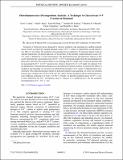Photoluminescence Decomposition Analysis: A Technique to Characterize N-V Creation in Diamond
Author(s)
Alsid, Scott T; Barry, John F.; Pham, Linh M; Schloss, Jennifer May; O'Keeffe, Michael F.; Cappellaro, Paola; Braje, Danielle A.; ... Show more Show less
DownloadPublished version (2.212Mb)
Publisher Policy
Publisher Policy
Article is made available in accordance with the publisher's policy and may be subject to US copyright law. Please refer to the publisher's site for terms of use.
Terms of use
Metadata
Show full item recordAbstract
Treatment of laboratory-grown diamond by electron irradiation and annealing has enabled quantum sensors based on negatively charged nitrogen-vacancy (N-V-) centers to demonstrate record sensitivities. Here we investigate the irradiation and annealing process applied to 28 diamond samples using an ambient-temperature, all-optical approach. As the presence of the neutrally charged nitrogen-vacancy (N-V0) center is deleterious to sensor performance, this photoluminescence decomposition analysis is first used to determine the concentration ratio of N-V- to N-V0 in diamond samples from the measured photoluminescence spectrum. The analysis hinges on (i) isolating each N-V charge state's emission spectrum and (ii) measuring the N-V- to N-V0 emission ratio, which is found to be 2.5±0.5 under low-intensity 532-nm illumination. Using the photoluminescence-decomposition-analysis method, we measure the effects of irradiation and annealing on conversion of substitutional nitrogen to N-V centers. Combining these measurements with a phenomenological model for diamond irradiation and annealing, we extract an estimated monovacancy creation rate of 0.52±0.26cm-1 for 1-MeV electron irradiation and an estimated monovacancy diffusion coefficient of 1.8 nm2/s at 850 C. Finally, we find that irradiation doses of 1018e-/cm2 or more deteriorate the N-V- decoherence time T2, whereas T1 is unaffected up to the the maximum investigated dose of 5×1018e-/cm2.
Date issued
2019-10-01Department
Massachusetts Institute of Technology. Department of Nuclear Science and Engineering; Massachusetts Institute of Technology. Department of PhysicsJournal
Physical review applied
Publisher
American Physical Society (APS)
Citation
Alsid, Scott T. et al. "Photoluminescence Decomposition Analysis: A Technique to Characterize N-V Creation in Diamond.' Physical review applied 12 (2019): 044033-1 to 044033-20 © 2019 The Author(s)
Version: Final published version
ISSN
2331-7019